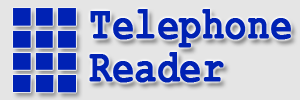F.A.Q.
What is the Telephone Reader System?
The system consists of a computer (preferably hooked to a network), software created at The University of Kansas, speech synthesizers, and telephone interface card(s). You can record your newspaper article by article, and your listeners can use their touch-tone telephones to listen, steering themselves up and down, through the articles, pages and sections. Listeners can also adjust the speed of the reading (without changing the pitch), and turn the volume up. Newspapers that are available as text files can be downloaded quickly, and then read out loud on demand by the speech synthesizers. Telephone Reader can deliver daily newspapers, monthly newsletters (your own and/or other organizations), Radio Reading Service broadcast schedules with book reviews, or even recorded programs which may (or may not) have aired on the Radio Reading Service.
What equipment do listeners need?
A touch-tone telephone is required. A speakerphone or headset telephone can be more comfortable to use for long listening periods.
How do listeners access the system?
You provide a phone number, which can roll over to as many lines as you have available. The number of lines is based on however many phone lines you want to buy, and the number of interface cards in your Telephone Reader computer. Each card can handle four lines. The listener is greeted with a standard message, headline message, or system alert message, and then is prompted to enter two four-digit passwords.
What if the listeners stay on too long, and the lines are always busy?
Telephone Reader allows two cutoff times to be set. One is for regular users, and the other is for demo mode. You might want to set the regular timer for, say, 20 minutes, and the demo mode for three minutes. The regular timer could be set to only engage when all lines are busy, and the demo timer would operate on all calls using the demo ID numbers to log on. When the timer activates, the system politely waits for a new command, or end of the story being read, then tells the caller that demand is high, or demo time has run out, and the call will be disconnected. Of course, each operator is free to create personalized messages.
What form of speech synthesis is used?
The voice and text-to-speech conversion are standard DECtalk units from Digital. Each phone line needs a DECtalk synthesizer. The listener is free to make the standard DECtalk adjustments, selecting the reading voice and reading speed.
How do listeners switch back and forth between the voice readings and synthesized speech?
Switching is automatic and transparent. The listener simply selects the file to read. If it's recorded, it plays back. If it's a text file, DECtalk automatically reads it. The only difference is in the keypad controls. For instance, there is a command to spell a word when listening to synthesized speech.
How many prompts will I have to record?
The system is supplied with all prompts in place, for both the listeners and the recording volunteers. Most prompts are standard. A few dozen will need to be recorded for your system, including the names of the newspapers, magazines, broadcast shows, etc. These are called Publications, and are held in Publication folders, which are held in Group folders. The system can accomodate multiple groups, publication folders, and publications. The prompts are typically voiced by Art Hadley, a producer-engineer with almost 30 years of commercial broadcast and voiceover experience. Recording the required prompts will be included in the price of your Telephone Reader system. Prompts may also be pre-recorded broadcast production, with theme music and/or effects.
How does the material get into the system?
For the newspapers that arrive on paper, the talent uses a standard phone to record, and reads the articles into the system. Each article is given a four digit number first. On playback, the listener doesn't actually ask for the story number; they start with a two digit category and the stories, up to 99, are delivered in order. The talent can use in-house telephones hooked up in recording studios, or can be authorized to record from home (or any location) by dialing in to the system. Newspapers available as text files must be downloaded from an FTP site, and categorized. This requires a first-time setup, but is fairly simple on a daily basis.
Can we provide out-of-town newspapers?
Yes. A Telephone Reader file exchange site has been set up. This allows you to add all the material stored on all Telephone Reader systems to your own. In other words, if (for instance) the New Jersey system recorded the Wall Street Journal every day, your listeners could select the New Jersey system offerings, and listen to the Journal just as easily as your own locally recorded papers.
